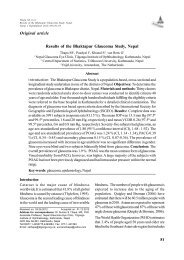nepjoph 2012.pmd - Nepalese Journal of Ophthalmology
nepjoph 2012.pmd - Nepalese Journal of Ophthalmology
nepjoph 2012.pmd - Nepalese Journal of Ophthalmology
You also want an ePaper? Increase the reach of your titles
YUMPU automatically turns print PDFs into web optimized ePapers that Google loves.
Bajimaya S et al<br />
Outcomes <strong>of</strong> phacoemulsification surgery<br />
Nepal J Ophthalmol 2012; 4(8):248-255<br />
Introduction<br />
The ultimate goal <strong>of</strong> a cataract surgery is to restore<br />
and maintain the pre-cataract vision and to alleviate<br />
other cataract-related symptoms.<br />
Phacoemulsification permits removal <strong>of</strong> the<br />
cataractous lens through a smaller incision, a quicker<br />
visual recovery and a faster physical rehabilitation.<br />
The first phacoemulsification was performed by<br />
Charles Kelman in 1967 (Kelman et al 1967). The<br />
techniques and results <strong>of</strong> cataract surgery have<br />
changed over the last three decades and<br />
phacoemulsification has become the preferred<br />
technique in developed countries (Seibel et al<br />
1999;Linebargeret al 2000; Lundstromet al 2002).<br />
In a survey on the practice styles <strong>of</strong> American<br />
Society <strong>of</strong> Cataract and Refractive Surgeons<br />
(ASCRS) members, it was found that only 3% <strong>of</strong><br />
the cataract surgeons did not use the<br />
phacoemulsification technique at all (Leaming et al<br />
2002). Similarly, 93% <strong>of</strong> the members <strong>of</strong> Japanese<br />
Society <strong>of</strong> Cataract and Refractive Surgery<br />
preferred phacoemulsification (Oshika et al 2000).<br />
The scenario in South Asian countries a decade<br />
before was opposite; less than 5% <strong>of</strong> the eye<br />
surgeons in India performed phacoemulsification<br />
(Basti et al 1999). Despite the rapid development<br />
in technology-driven cataract surgery in the<br />
developed world, it is still in its infancy in developing<br />
countries.<br />
Cataract surgery is the most common intraocular<br />
surgery performed worldwide. Over the past two<br />
decades, extra-capsular cataract extraction (ECCE)<br />
has become a more commonly performed<br />
procedure than intra-capsular cataract extraction<br />
(ICCE), which is now performed less <strong>of</strong>ten in<br />
Nepal. In developing countries, manual sutureless<br />
small incision cataract surgery (SICS) has been<br />
accepted as a low cost cataract surgery and the<br />
best option for addressing high volume cataract<br />
backlog (Ruit et al 2000; Chang DF 2005). In<br />
recent years, phacoemulsification technique has<br />
brought cataract surgery results as close to<br />
anatomical perfection as possible. However,<br />
implementation <strong>of</strong> phacoemulsification is limited by<br />
the startup and training cost. As a result,<br />
ophthalmologists in developing countries such as<br />
Nepal, have limited opportunity to acquire the skill<br />
<strong>of</strong> phacoemulsification. To address this problem,<br />
the Association for Ophthalmic Cooperation in Asia<br />
(AOCA) in joint collaboration with the Nepal Netra<br />
Jyoti Sangh (NNJS) started the first bi-annual<br />
national phacoemulsification training program in<br />
Nepal from December 2007, with the financial<br />
support <strong>of</strong> the Japan International Cooperation<br />
Agency (JICA). The author (BS), after completing<br />
a one-month phaco training program, started<br />
performing phacoemulsification independently. The<br />
objective <strong>of</strong> this study was to analyze the surgical<br />
outcome <strong>of</strong> phacoemulsification by a young<br />
ophthalmologist after receiving training in Nepal.<br />
Materials and methods<br />
This study was a hospital-based retrospective one<br />
that included data from 172 patients that underwent<br />
phacoemulsification with foldable intraocular lens<br />
implantation by a single surgeon (BS) during a<br />
period <strong>of</strong> 18 months (1 st July, 2008 to 31 st<br />
December, 2009) and who had also completed a<br />
6-week follow-up. Diabetics and hypertensives<br />
were included. Cataract grading was classified under<br />
Lens Opacity Classification System (Chylac et al<br />
1989). Nuclear sclerosis grades 1 and 2 were<br />
included in one group and Grades 3 and 4 were<br />
included in a second group. Posterior sub-capsular<br />
cataracts (PSCC), posterior polar cataracts,<br />
traumatic cataracts without subluxation, and myopic<br />
patients were also included. Preoperative visual<br />
acuity, slit lamp biomicroscopy findings with 90D<br />
examination, corneal astigmatism and IOL power<br />
calculations were recorded. Under<br />
peribulbaranesthesia, phacoemulsification was<br />
performed by a clear corneal incision (CCI). The<br />
CCI <strong>of</strong> 2.8 mm was placed at the12’O clock<br />
position in cases <strong>of</strong> with-the -rule (WTR)<br />
astigmatism and a superior temporal CCI was<br />
performed in cases <strong>of</strong> against-the-rule (ATR)<br />
astigmatism. The anterior chamber was refilled with<br />
hydroxypropyl methyl cellulose 2%. Continuous<br />
curvilinear capsulorrhexis (CCC) was then<br />
249




